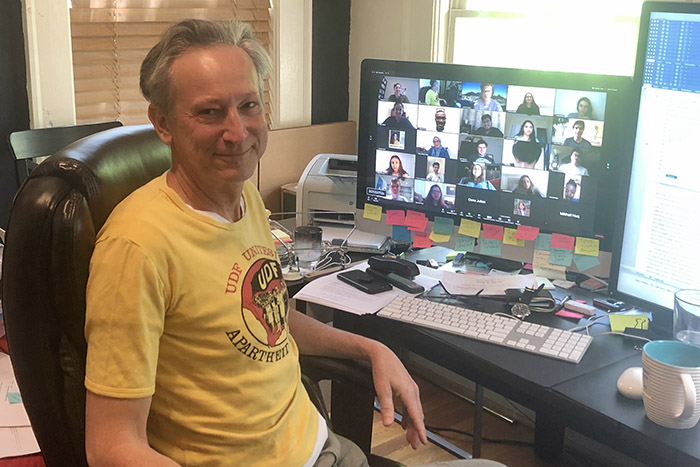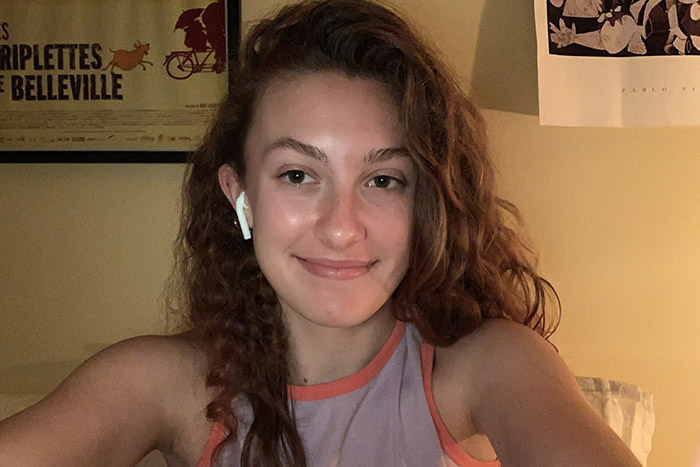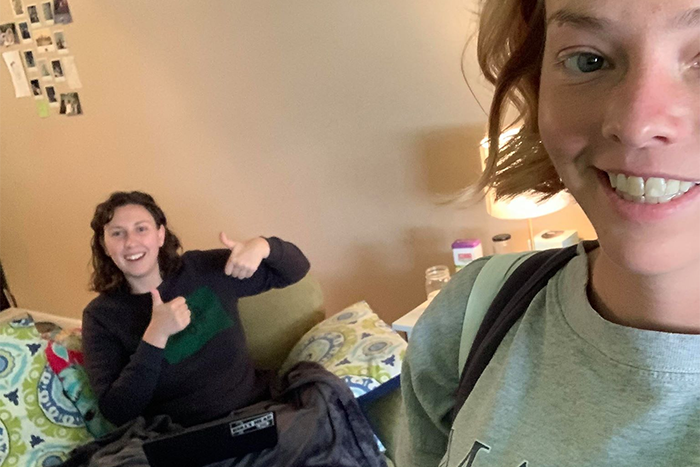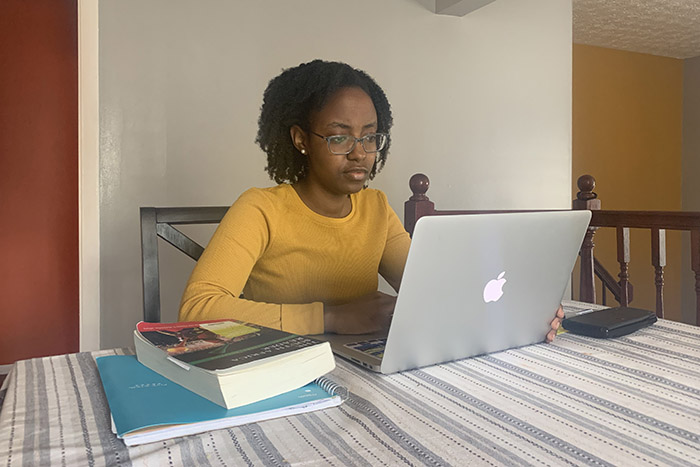Although studying from home was not how Michelle Mugo envisioned completing her senior year, her takeaways include lessons in adapting to change that will help carry her through life. History professor Clifton Crais also learned valuable lessons – supported by his belief that the pandemic is helping us become better teachers, students and citizens.
As the semester drew to a close, Crais wrapped up their time together in a special way for Mugo and her fellow seniors.
“At the end of our last full class I put on my academic gown, played ‘Pomp and Circumstance’ and had all the seniors stand,” he says. “We all then clapped and said congratulations. And I think a few of us shed some tears. I know I did.”
“Classes that Click” is a series showcasing how Emory’s commitment to stellar education continues during the COVID-19 pandemic and how many lessons learned will further enhance life at the university when everyone returns to classrooms together.
Crais, professor of history and director of the Institute of African Studies, is joined by his teaching assistant, Georgia Brunner, and students Bronwen Boyd and Michelle Mugo from his “Making of Modern South Africa” class.
The course: “Making of Modern South Africa” (History/African Studies 367)
“Making of Modern South Africa” (HIST 367) introduces students to the history of South Africa from a society based on the principle of systematic racial segregation to a multiracial democracy. Topics include the origins of racial segregation and apartheid, nationalist struggles and the challenges of post-apartheid democracy.
Moving toward remote learning
How did you prepare for this phase of remote learning?
Crais: I feel like I had a slight advantage. Just as the virus was spreading through China, we were discussing the 1918 influenza pandemic and its impact in South Africa. The more I read the news the more concerned I became. So, I strongly encouraged my students to take all their materials when they left for spring break. This meant that the majority of the class had their notes, books, etc., when we transitioned to remote teaching.
Brunner: Dr. Crais and I rewrote the syllabus and changed the midterm and final exam.
Boyd: It was difficult to figure out where I wanted to do my synchronous courses because I am living in a house with two educators who also need a quiet environment and strong internet connection. Because my dad’s work requires him to be on video calls most of the day, my mom and I had to share upstairs spaces.
Mugo: I reorganized my room to create some study space. I prepared an Excel spreadsheet calendar to help me track the assignments, Zoom calls and other activities related to learning.
What was one of your primary challenges in shifting to a remote format and how did you meet it?
Crais: Everyone is naturally very anxious, and people deal with this in quite different ways. I have found it critically important to think about each and every student and to work with them individually. A student living in a large house is much different than a student in a small apartment caring for nieces while their aunt is working in the hospital. I have adopted a hybrid model of synchronous and asynchronous teaching. I tape my lectures so students can listen to them whenever they want. We also have two class periods of discussion, plus office hours. I also used Canvas very intensively, sending students messages almost daily, posting materials and staying connected.
Ultimately, an overarching challenge is to teach effectively and to communicate why education – and why an Emory education – really matters in this state of emergency. This may be an especially important challenge to humanities and social sciences. I have tried to show how history matters and how we can make history – even if we are stuck in our living rooms.
Boyd: Working in the same environment where I was meant to be resting had pretty adverse effects on my mental health, especially in the first few weeks. It felt like even when I wasn’t working, I had the anxieties of classwork and work for my job (which also moved online) weighing on me. After a while, I found a better balance by setting up a schedule with time allocated for each of these activities.
Mugo: The main challenge was adjusting to studying at home again as I have not done that since high school. I like to study at the library or other environments and rarely stay in the same place for too long. Thus, being confined indoors was not ideal for studying. Changing locations around the house helped improve my concentration. An equally challenging factor was navigating study spaces in the house as my mum and brother are also studying and my dad is working from home. We had to make sure that two people were not in the same room having Zoom calls at the same time.
Putting remote learning into practice
What has been a pleasant surprise about remote learning?
Crais: I am just amazed – and so proud – of how committed the students have been. They come to class prepared, have submitted some wonderful responses to the assigned reading and we have had some really great class discussions. Zoom has worked extremely well. The vast majority of students have been able to focus really well even as our minds are elsewhere.
Boyd: I’m surprised by how much more time I have for myself now that I don’t have to go to classes physically. This has left me with far more time to take care of myself and do things that make me happy.
Mugo: The work-life balance has been better than expected. I am putting more effort into prioritizing my mental health in order to cope with all that is happening around us and to do well with my studies. Remote learning has given me more flexibility with my schedule.
How are you staying engaged with your students or classmates and professors?
Crais: My wonderful teaching assistant, Georgia Brunner, also has been reaching out to students, meeting with them online and just demonstrating the importance of human decency. We also take attendance. If someone misses a class, we follow up.
Brunner: Having regular class time I know is a challenge for students in other time zones but I do think that it helps keep up engagement.
Boyd: I try to text and FaceTime my classmates outside of class, and I’ve been periodically emailing my professors to try to stay on top of my work for class.
Mugo: I attend Zoom class sessions as well as office hours so I can interact with my professors and classmates. My classmates arrange Zoom calls to talk about the material and help each other understand the concepts. We check up on each other and bond over the shared experience we are going through as we are still trying to come to terms with the reality of the situation.
Lessons to be carried forward
What’s one lesson you’ve learned during this transition, and how will you use it later?
Crais: The importance of human contact and our common humanity, beginning with the simple act of looking into another person’s eyes. I will renew my effort to develop a unique relationship with each and every student, no matter how large the class. Paradoxically, online teaching has taught me the importance of a residential college experience. We are learning new things about the world and about each other. We are going to come out of this crisis better teachers and better students – and citizens.
Brunner: Face time is key to engagement. I think encouraging students to come to office hours earlier in the semester will ensure that students have one-on-one contact, which really helps the student and instructor engage better.
Boyd: Unless you set aside time for each of your tasks, it is difficult for your brain to separate work from rest. I’ve also learned that it is important to exercise as often as you feel able. I think I’ll be much better about getting my work done earlier in the day and leaving the evenings for myself as often as possible.
Mugo: I have always been motivated and hardworking, but my self-discipline was tested during this transition. It was important to take breaks and allow myself to process and express my frustrations without letting it hinder my goals. It is okay for my routine to change and to adapt to the changes. While it is important to constantly improve, it is equally important to congratulate myself for every achievement, whether big or small. I am redefining what success looks like for me.
In addition to focusing on the university’s educational mission, Emory experts are on the front lines of the pandemic – caring for patients, researching possible treatments and vaccines and sharing knowledge to help inform and prepare the public. Visit Emory’s COVID-19 page for the latest updates.




